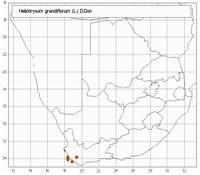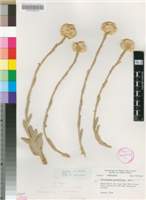Common names:
Wit sewejaartjie
Origin of name:
grandiflorus /-a/-um = with large flowers
Diagnostic characters:
Large heads in compact inflorescencePale yellow bracts
Description:
Perennial, base woody, stems several from the crown, decumbent then erect to c. 450 mm, simple or subsimple, loosely woolly, densely leafy near the base, then distantly so, pedunculoid and bracteate under the compound inflorescences. Radical leaves up to 100 x 60 mm, obovate or broadly elliptic becoming oblong to oblong-lanceolate then linear-lanceolate upwards, apex obtuse to subacute, uppermost reduced leaves acute with a white papery appendage, base broad, clasping, both surfaces loosely greyish-white woolly. Heads homogamous, campanulate, c. 7 x 7 mm, many in dense terminal spherical clusters 20�50 mm across. Involucral bracts in c. 10 series, graded, imbricate, inner shortly exceeding flowers, minutely radiating, obtuse or subacute, dull, creamy white. Receptacle nearly smooth. Flowers 70�107. Achenes 0.75 mm long, barrel-shaped, ribbed, glabrous. Pappus bristles many, equaling corolla, tips subplumose, bases cohering strongly by patent cilia.
Flowering between December and February.
Distribution:
Mountain slopes. Endemic to the mountains of the Cape Peninsula.
Fynbos Biome.
Notes:
Sometimes confused with H. fruticans.
Taxonomy:
Literature:
Helichrysum grandiflorum (L.) D. Don in Sweet, Hort. Brit. 222 (1826); Less., Syn. Comp. 289 (1832); DC., Prodr. 6: 175 (1838); Harv. in F.C. 3: 224 (1865); Moeser in Bot. Jb. 44: 309 (1910); Levyns in Adamson & Salter, Fl. Cape Penins. 782 (1950).
Type:
Cape of Good Hope (LINN 989.3).
Synonym(s):
Gnaphalium grandiflorum L., Sp. Pl. 850 (1753).
G. verbascifolium Schrank in Denkschr. K. Akad. Wiss. M�nch. 8: 150 (1824). Type: Cape of Good Hope, Brehm s.n. (M, holo.).
Vouchers:
Bolus 3874 (BOL); Compton 8218 (NBG); Esterhuysen 26853 (BOL,); Gillett 3498 (PRE).

